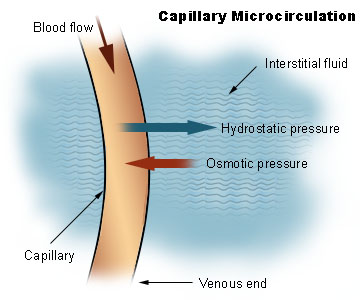Microcirculation: Difference between revisions
Rim Halaby (talk | contribs) No edit summary |
Rim Halaby (talk | contribs) |
||
| Line 30: | Line 30: | ||
**Reflection coefficient ( σ ) | **Reflection coefficient ( σ ) | ||
* Starling's equation | * Starling's equation reads as follows: | ||
[[Image:Starling_Law.png]] | [[Image:Starling_Law.png]] | ||
Revision as of 18:10, 25 October 2012

|
WikiDoc Resources for Microcirculation |
|
Articles |
|---|
|
Most recent articles on Microcirculation Most cited articles on Microcirculation |
|
Media |
|
Powerpoint slides on Microcirculation |
|
Evidence Based Medicine |
|
Clinical Trials |
|
Ongoing Trials on Microcirculation at Clinical Trials.gov Trial results on Microcirculation Clinical Trials on Microcirculation at Google
|
|
Guidelines / Policies / Govt |
|
US National Guidelines Clearinghouse on Microcirculation NICE Guidance on Microcirculation
|
|
Books |
|
News |
|
Commentary |
|
Definitions |
|
Patient Resources / Community |
|
Patient resources on Microcirculation Discussion groups on Microcirculation Patient Handouts on Microcirculation Directions to Hospitals Treating Microcirculation Risk calculators and risk factors for Microcirculation
|
|
Healthcare Provider Resources |
|
Causes & Risk Factors for Microcirculation |
|
Continuing Medical Education (CME) |
|
International |
|
|
|
Business |
|
Experimental / Informatics |
Editor-In-Chief: C. Michael Gibson, M.S., M.D. [1]; Assistant Editor(s)-in-Chief: Rim Halaby
Overview
- The microcirculation is the blood flow through blood vessels smaller than 100 µm (i.e. arterioles, capillaries, and venules).
- The main functions of the microcirculation are transporting blood cells and substances to/from the tissues, and as body coolant in thermoregulation processes.
- It also contributes to tissues color and stiffness.
- Diffusion is the capillary exchange of substances across the endothelial cells membranes.
Determinants of Capillary Exchange
- 1- Surface area of the capillary bed
- It is dependent on the metabolic activity of the tissue.
- 2- Permeability of the capillary bed
- 3- Free diffusion coefficient of the substances to be exchanged
- It is dependent on the substance size, charge and lipid solubility.
- 4- Concentration of the substances to be exchanged
- The difference in concentration of the substances in the blood and in the interstitium drives the flow of substances across the capillary bed.
Starling's Law
- The Starling equation is an equation that illustrates the role of hydrostatic and oncotic forces (the so-called Starling forces) in the movement of fluid across capillary membranes.
- According to Starling's equation, the movement of fluid depends on six variables:
- Capillary hydrostatic pressure ( Pc )
- Interstitial hydrostatic pressure ( Pi )
- Capillary oncotic pressure ( πc )
- Interstitial oncotic pressure ( πi )
- Filtration coefficient ( Kf )
- Reflection coefficient ( σ )
- Starling's equation reads as follows:
Transvascular Exchange of Water
- Water moves across the capillary walls based on the same principles of Starling's law and thus it depends on the difference of hydrostatic pressures and oncotic pressures in the blood vessels and in the interstitium.
- Filtration is the movement of water out of the vessels
- Reabsorption is the movement of water in the vessels.